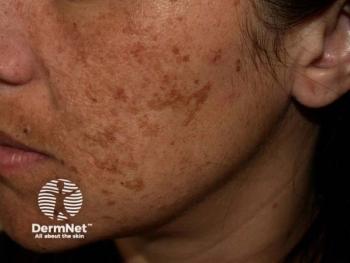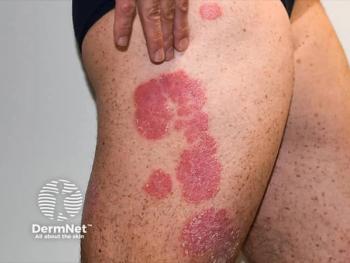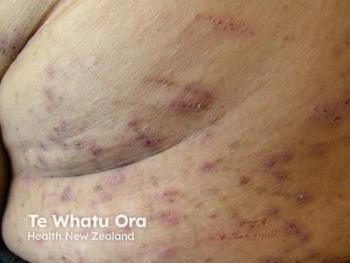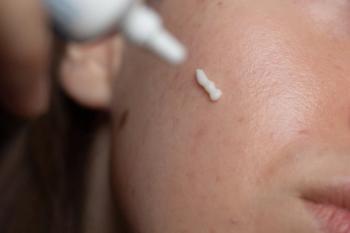
Clinical Pearls, Practical Approaches, and New Perspectives: Highlights From the First Days of DERM 2025
Key Takeaways
- Chronic pruritus involves a neuroimmune spectrum, with emerging therapies targeting JAK, IL, and other pathways. Proper patient assessment and basic management strategies are crucial.
- Chronic hand eczema affects up to 10% of the population, with risk factors including wet work and atopic dermatitis. Treatment includes supportive management and newly approved therapies.
The DERM 2025 midway recap includes tips for atopic dermatitis, chronic hand eczema, and pruritus.
The opening days of
Expert clinicians including dermatologists, dermatology nurse practitioners, and dermatology physician assistants led symposia on topics ranging from managing risk factors to refining therapeutic choices across complex inflammatory conditions. True to its mission, DERM 2025 has focused on real-world cases with high-impact pearls. The conference also included thoughtful poster spotlight sessions with expert commentary as well as product theaters showcasing emerging data and therapies shaping the dermatology pipeline.
Beyond clinical content, DERM 2025’s keynote featured world surf champion Bethany Hamilton joined by dermatologists Suneel Chilukuri, MD, and Gilly Munavalli, MD, to explore “surfing past fear”—a powerful metaphor for the profession’s evolving challenges. Similarly, other sessions discussed patient communication, interpreting clinical studies, and career development, adding depth to the program.
In addition to the daily interviews and session recaps, below are a few highlights from the first half of the conference.
Wiping Out Chronic Pruritus
In this session,
- Chronic Itch conditions are in a neuroimmune spectrum, ranging from primary an inflammatory itch to primarily a neurogenic itch:
Scabetic itch, atopic itch, insect bite=>
Dry skin, prurigo nodularis, uremic pruritus =>
Postherpetic, notalgia paresthetica, scalp pruritus
- Itch and suicidal ideation are real; check on patients.
- Ask the right questions: Look at duration, severity, localization, periodicity, sleep impact, itch history, exacerbating issues, alleviating factors, drug use, atopy history, travel history.
- Investigate: Is it a rash that itches or an itch that rashes?
- For an itch of unknown origin that lasts more than 6 weeks: consider immune dysregulation.
- Use due diligence with initial workup.
- Off-label options include immunomodulating agents, alternative/complementary medicine, rescue agents, neuromodulating agents.
- Don't forget the basics: soft cotton clothing, non-alkaline soaps, lukewarm water for bathing, and avoid heat, dry climate, alcohol, spicy food, frequent bathing.
- There is good news: Many emerging therapies on the horizon, targeting JAK1, JAK2, JAK3, IL-13, IL-31RA, OSMRβ, TSLP, KOT agonist, MOT antagonist, NK1R, TrkA, PDE4, TSLP
Surf’s Rough: Chronic Hand Eczema Overview
David Cohen, MD, MPH, reviewed the challenging and pervasive issues in chronic hand eczema and discussed the recently approvement treatment.2 A few important points to consider:
- Prevalence in the general population is as high as 10%; studies estimate lifetimes prevalence in health care workers as high as 33%.
- Risk factors include exposure to wet work, frequent hand washing, and atopic dermatitis.
- European Union identified etiological subtypes (irritant contact dermatitis, atopic hand eczema, allergic contact dermatitis, protein contact dermatitis) and morphological subtypes (hyperkeratotic hand eczema, acute recurrent vesicular hand eczema, nummular hand eczema, pulpitis).
However, there is no reliable correlation between etiology and morphology; underlying pathophysiology is shared for subtypes.
- Patch testing can be helpful in management CHE; nickel, fragrances, and preservatives are usual suspects.
- Glove-wearing can also be an issue.
- Treatment algorithm includes basic supportive management; traditional topical therapies; newly approved targeted topical therapy (delgocitinib); and systemic and advanced therapies
Soaking Up the Topicals for AD
Alexa Hetzel, MS, PA-C, reviewed the topical options available for atopic dermatitis, including newer agents and expanding indications on the horizon, reminding attendees that there are plenty of good options.3 A few key points:
- Corticosteroids: Available since 1952, these agents work well but have cons (eg, trophy, patient steroid phobias, rebound flare, systemic absorption).
- Nonsteroidal agents: Include tacrolimus 0.1% and 0.03%, pimecrolimus 1%, and crisaborole 2%; they can cause stinging and burning.
- JAK inhibitors: Includes ruxolitinib 1.5%; despite box warning, it is considered to have relatively good safety profile. On the horizon: delgocitinib 2%, which was recently approved for chronic hand eczema.
- Phosphodiesterase 4 (PDE-4) inhibitors: Roflumilast 0.15%; it is contraindicated in patients with moderate to severe liver impairment but otherwise well tolerated.
- Aryl hydrocarbon receptor (AhR) agonist: tapinarof 1%, well tolerated and no contraindications.
Interested in additional conference coverage happening this week? Read highlights from
References
1. Friedman A. Itch Break: Wiping Out Chronic Pruritus. Presented at DERM 2025 NP/PA CME Conference; July 23-26, 2025; Las Vegas, Nevada.
2. Cohen DE. Surf’s Rough: Chronic Hand Eczema Overview. Presented at DERM 2025 NP/PA CME Conference; July 23-26, 2025; Las Vegas, Nevada.
3. Hetzl A. Soakin’ Up the Topical Options For AD. Presented at DERM 2025 NP/PA CME Conference; July 23-26, 2025; Las Vegas, Nevada.
Newsletter
Like what you’re reading? Subscribe to Dermatology Times for weekly updates on therapies, innovations, and real-world practice tips.


















